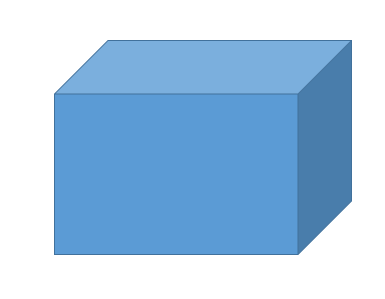
Verify the Euler formula for the solid:


Answer
550.8k+ views
Hint: First of all, we will mention the Euler formula which needs to be verified in the question. Then, we will individually find the number of edges, faces and whatever is required to put in the formula to verify it.
Step-By-Step answer:
We know that the Euler’s formula is given by the following expression:-
\[ \Rightarrow \] V – E + F = 2; where V refers to the number of vertices in the figure, E refers to the term “number of edges” in the figure and F refers to the “number of faces” in the figure.
The figure given above is definitely a cuboid because it consists of the rectangles as its faces / the coverings.
We know that in a cuboid, 8 vertices are connected using 12 edges which eventually leads to 6 faces.
Therefore, we have V = 8, E = 12 and F = 6.
$ \Rightarrow $ LHS = V – E + F = 8 – 12 + 6
Solving the calculations to get the following:-
$ \Rightarrow $ LHS = V – E + F = - 4 + 6
Solving the calculations further to get the following:-
$ \Rightarrow $ LHS = V – E + F = 2
We can clearly see that this is equal to the RHS.
Hence, LHS = RHS.
$\therefore $ the Euler formula is verified.
Note: The students must note that we can only look at the two of the faces, because we are seeing a side view, 3 of its faces are covered from behind. To help understand this, look at any closed box or carton to imagine and visualize it. It will have 6 faces which are the outer covering of the boxes. Now, count the corners of the box which will come to be equal to 8 and similarly count the joining of these edges which will come to be 12.
Step-By-Step answer:
We know that the Euler’s formula is given by the following expression:-
\[ \Rightarrow \] V – E + F = 2; where V refers to the number of vertices in the figure, E refers to the term “number of edges” in the figure and F refers to the “number of faces” in the figure.
The figure given above is definitely a cuboid because it consists of the rectangles as its faces / the coverings.
We know that in a cuboid, 8 vertices are connected using 12 edges which eventually leads to 6 faces.
Therefore, we have V = 8, E = 12 and F = 6.
$ \Rightarrow $ LHS = V – E + F = 8 – 12 + 6
Solving the calculations to get the following:-
$ \Rightarrow $ LHS = V – E + F = - 4 + 6
Solving the calculations further to get the following:-
$ \Rightarrow $ LHS = V – E + F = 2
We can clearly see that this is equal to the RHS.
Hence, LHS = RHS.
$\therefore $ the Euler formula is verified.
Note: The students must note that we can only look at the two of the faces, because we are seeing a side view, 3 of its faces are covered from behind. To help understand this, look at any closed box or carton to imagine and visualize it. It will have 6 faces which are the outer covering of the boxes. Now, count the corners of the box which will come to be equal to 8 and similarly count the joining of these edges which will come to be 12.
Recently Updated Pages
Master Class 12 Business Studies: Engaging Questions & Answers for Success

Master Class 12 Economics: Engaging Questions & Answers for Success

Master Class 12 English: Engaging Questions & Answers for Success

Master Class 12 Maths: Engaging Questions & Answers for Success

Master Class 12 Social Science: Engaging Questions & Answers for Success

Master Class 12 Chemistry: Engaging Questions & Answers for Success

Trending doubts
What are the major means of transport Explain each class 12 social science CBSE

Which are the Top 10 Largest Countries of the World?

Draw a labelled sketch of the human eye class 12 physics CBSE

How much time does it take to bleed after eating p class 12 biology CBSE

Explain sex determination in humans with line diag class 12 biology CBSE

Differentiate between homogeneous and heterogeneous class 12 chemistry CBSE




